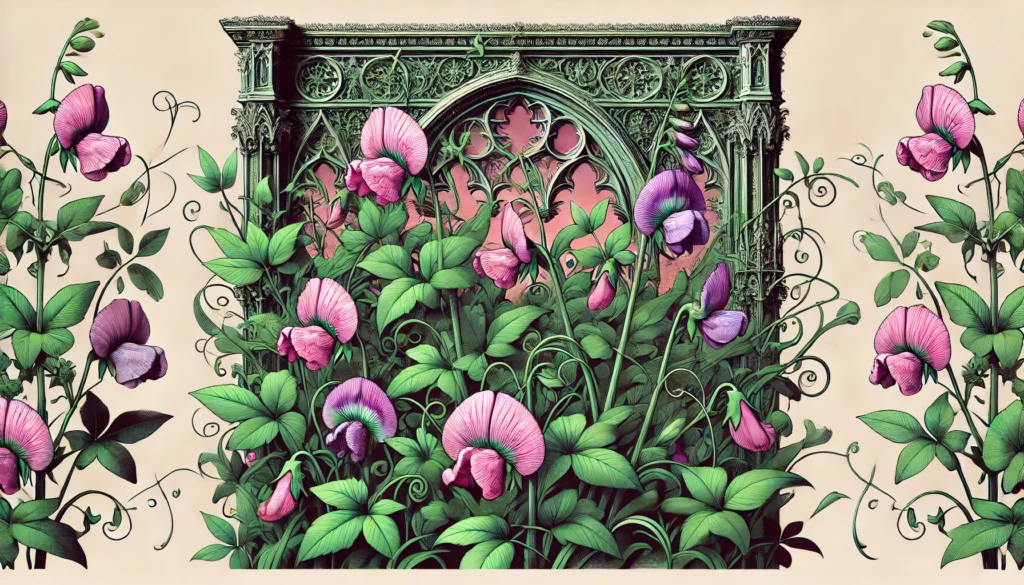

Home » Cat Plants » Can the Perennial Pea Plant be Harmful to Cats?

The Perennial Pea (Lathyrus latifolius), also known as Everlasting Pea or Sweet Pea, is a flowering vine commonly found in gardens and along roadsides. While its colorful blooms may be appealing, this plant can actually be quite toxic to cats if ingested. The Perennial Pea is aminoproprionitrite, which can cause neurological issues in cats.
Ingestion may cause mild gastrointestinal upset, but is generally not life-threatening.
Ingestion can result in mild symptoms like vomiting, diarrhea, or drooling. Rarely fatal but may require veterinary care.
Eating these plants can lead to more pronounced symptoms like abdominal pain, lethargy, or difficulty breathing. Veterinary intervention may be necessary.
Ingesting even small amounts can cause severe symptoms like organ damage, seizures, or cardiac failure without rapid treatment.
All parts of these plants are extremely poisonous to cats and can quickly lead to death, even with immediate veterinary care.
** Please note: Please note that toxicity level can vary based on the amount ingested and the specific cat. It's always best to keep these plants completely inaccessible to cats and seek immediate veterinary care or call the poison hotline if you suspect your cat has ingested any part of a toxic plant.
If a cat ingests any part of the Perennial Pea plant, it may experience a range of concerning symptoms:The toxic principle in Perennial Pea is aminoproprionitrite, which can cause neurological issues in cats. Common signs of Perennial Pea poisoning include:
If you suspect your cat has eaten any part of a Perennial Pea plant, contact your veterinarian or pet poison control hotline immediately.
If you bring your cat to the vet suspecting Perennial Pea poisoning, here’s what you can expect:
The best prevention is keeping Perennial Pea plants away from areas where your cat spends time. If you think your cat has eaten this toxic plant, swift veterinary care is essential for the best chance at a full recovery.

A: Yes, the Perennial Pea plant is harmful to cats as it contains toxic compounds like BAPN. Ingesting this plant can lead to neurological symptoms, lethargy, and even organ impairment.
A: If a cat consumes the Perennial Pea plant, it may develop symptoms such as weakness, tremors, or difficulty walking. Immediate veterinary care is crucial to prevent more severe reactions.
A: Yes, all parts of the Perennial Pea plant, including the seeds and flowers, are toxic to cats. The plant contains harmful alkaloids that can affect your cat’s nervous system.
A: To protect your cat, avoid growing Perennial Pea plants in areas accessible to pets. Instead, choose non-toxic plants like spider plants or basil that are safer for your cat.
A: Symptoms of Perennial Pea poisoning in cats include vomiting, tremors, lethargy, and difficulty walking. If these symptoms occur, contact your veterinarian immediately for treatment.
A: Home treatment for Perennial Pea poisoning is not recommended. It’s important to seek professional veterinary care to manage symptoms and ensure a safe recovery for your cat.
The perennial pea plant, Lathyrus latifolius, has a rich history that spans continents and centuries. Native to Europe and Northwest Africa, this hardy climbing vine with vibrant flowers has long been cherished for its beauty and adaptability. It made its way to American gardens before 1720, already popular in European landscapes. The plant’s journey to widespread acclaim was boosted when Thomas Jefferson sowed it at Monticello in 1807, solidifying its place in early American horticulture.
Over time, the perennial pea’s vigorous growth and showy flowers made it a favorite for roadsides and gardens alike. Its ability to thrive in various conditions led to its naturalization across much of the United States, transforming it from an imported ornamental to a familiar sight in the American landscape. Today, this resilient plant continues to captivate gardeners with its colorful blooms and hardy nature, a living testament to its enduring appeal through the ages.
Please note: The information shared in this post is for informational purposes only and should not be considered as veterinary medical advice.